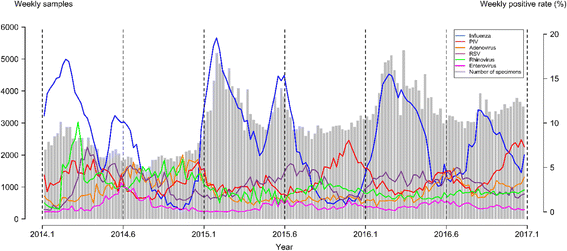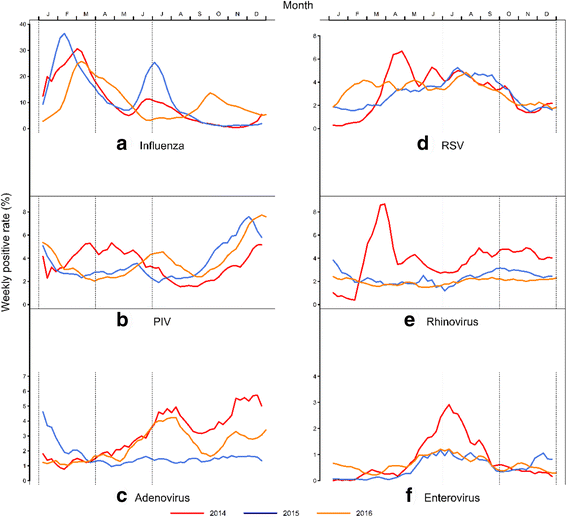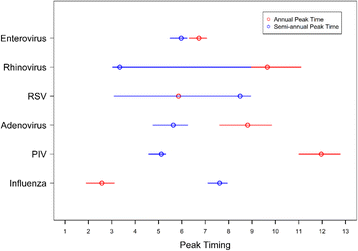Possible interference between seasonal epidemics of influenza and other respiratory viruses in Hong Kong, 2014-2017
- PMID: 29246199
- PMCID: PMC5732536
- DOI: 10.1186/s12879-017-2888-5
Possible interference between seasonal epidemics of influenza and other respiratory viruses in Hong Kong, 2014-2017
Abstract
Background: Unlike influenza viruses, little is known about the prevalence and seasonality of other respiratory viruses because laboratory surveillance for non-influenza respiratory viruses is not well developed or supported in China and other resource-limited countries. We studied the interference between seasonal epidemics of influenza viruses and five other common viruses that cause respiratory illnesses in Hong Kong from 2014 to 2017.
Methods: The weekly laboratory-confirmed positive rates of each virus were analyzed from 2014 to 2017 in Hong Kong to describe the epidemiological trends and interference between influenza viruses, respiratory syncytial virus (RSV), parainfluenza virus (PIV), adenovirus, enterovirus and rhinovirus. A sinusoidal model was established to estimate the peak timing of each virus by phase angle parameters.
Results: Seasonal features of the influenza viruses, PIV, enterovirus and adenovirus were obvious, whereas annual peaks of RSV and rhinovirus were not observed. The incidence of the influenza viruses usually peaked in February and July, and the summer peaks in July were generally caused by the H3 subtype of influenza A alone. When influenza viruses were active, other viruses tended to have a low level of activity. The peaks of the influenza viruses were not synchronized. An epidemic of rhinovirus tended to shift the subsequent epidemics of the other viruses.
Conclusion: The evidence from recent surveillance data in Hong Kong suggests that viral interference during the epidemics of influenza viruses and other common respiratory viruses might affect the timing and duration of subsequent epidemics of a certain or several viruses.
Keywords: Influenza; Interference; Respiratory viruses; Seasonal epidemics.
Conflict of interest statement
Ethics approval and consent to participate
Not applicable.
Consent for publication
Not applicable.
Competing interests
The authors declare that they have no competing interests.
Publisher’s Note
Springer Nature remains neutral with regard to jurisdictional claims in published maps and institutional affiliations.
Figures




Similar articles
-
Severe acute respiratory infection in children in a densely populated urban slum in Kenya, 2007-2011.BMC Infect Dis. 2015 Feb 25;15:95. doi: 10.1186/s12879-015-0827-x. BMC Infect Dis. 2015. PMID: 25879805 Free PMC article.
-
Part 4. Interaction between air pollution and respiratory viruses: time-series study of daily mortality and hospital admissions in Hong Kong.Res Rep Health Eff Inst. 2010 Nov;(154):283-362. Res Rep Health Eff Inst. 2010. PMID: 21446214
-
Viral etiology and seasonality of influenza-like illness in Gabon, March 2010 to June 2011.BMC Infect Dis. 2014 Jul 7;14:373. doi: 10.1186/1471-2334-14-373. BMC Infect Dis. 2014. PMID: 25000832 Free PMC article.
-
Global patterns in monthly activity of influenza virus, respiratory syncytial virus, parainfluenza virus, and metapneumovirus: a systematic analysis.Lancet Glob Health. 2019 Aug;7(8):e1031-e1045. doi: 10.1016/S2214-109X(19)30264-5. Lancet Glob Health. 2019. PMID: 31303294
-
Occurrence of respiratory virus: time, place and person.Pediatr Infect Dis J. 2004 Jan;23(1 Suppl):S58-64. doi: 10.1097/01.inf.0000108193.91607.34. Pediatr Infect Dis J. 2004. PMID: 14730271 Review.
Cited by
-
Respiratory virus surveillance in hospitalized children less than two-years of age in Kenema, Sierra Leone during the COVID-19 pandemic (October 2020- October 2021).PLoS One. 2023 Oct 10;18(10):e0292652. doi: 10.1371/journal.pone.0292652. eCollection 2023. PLoS One. 2023. PMID: 37816008 Free PMC article.
-
Coinfection and Interference Phenomena Are the Results of Multiple Thermodynamic Competitive Interactions.Microorganisms. 2021 Sep 29;9(10):2060. doi: 10.3390/microorganisms9102060. Microorganisms. 2021. PMID: 34683381 Free PMC article.
-
Modelled estimates of hospitalisations attributable to respiratory syncytial virus and influenza in Australia, 2009-2017.Influenza Other Respir Viruses. 2022 Nov;16(6):1082-1090. doi: 10.1111/irv.13003. Epub 2022 Jun 30. Influenza Other Respir Viruses. 2022. PMID: 35775106 Free PMC article.
-
Prolonged Primary Rhinovirus Infection of Human Nasal Epithelial Cells Diminishes the Viral Load of Secondary Influenza H3N2 Infection via the Antiviral State Mediated by RIG-I and Interferon-Stimulated Genes.Cells. 2023 Apr 13;12(8):1152. doi: 10.3390/cells12081152. Cells. 2023. PMID: 37190061 Free PMC article.
-
Interferon-Dependent and Respiratory Virus-Specific Interference in Dual Infections of Airway Epithelia.Sci Rep. 2020 Jun 24;10(1):10246. doi: 10.1038/s41598-020-66748-6. Sci Rep. 2020. PMID: 32581261 Free PMC article.
References
-
- Nair H, Brooks WA, Katz M, Roca A, Berkley JA, Madhi SA, Simmerman JM, Gordon A, Sato M, Howie S, et al. Global burden of respiratory infections due to seasonal influenza in young children: a systematic review and meta-analysis. Lancet. 2011;378(9807):1917–1930. doi: 10.1016/S0140-6736(11)61051-9. - DOI - PubMed
-
- Galindo-Fraga A, Ortiz-Hernandez AA, Ramirez-Venegas A, Vazquez RV, Moreno-Espinosa S, Llamosas-Gallardo B, Perez-Patrigeon S, Salinger M, Freimanis L, Huang CY, et al. Clinical characteristics and outcomes of influenza and other influenza-like illnesses in Mexico City. Int J Infect Dis. 2013;17(7):e510–e517. doi: 10.1016/j.ijid.2013.01.006. - DOI - PMC - PubMed
MeSH terms
Grants and funding
LinkOut - more resources
Full Text Sources
Other Literature Sources
Medical

